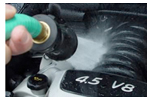| Compliance Summary |
 Compliance Summary Tool Compliance Summary Tool
|
 |
| Transportation Modes |
|
 |
| Service Functions |
|
 |
| Regulations |
|
 |
| All Topics |
|
 |
|
Please note: This summary is provided to help you understand the regulations. Consult the references provided for links to the full text of the regulations.
 Cleaning, Parts Cleaners (Water-based) Cleaning, Parts Cleaners (Water-based)
This section provides information about wastewater from parts and equipment cleaning operations. Examples include aqueous (water-based) parts washers used to clean used engine parts after disassembly at vehicle maintenance operations.
Other types of cleaning operations are covered elsewhere on TERC, including:
For information on solid wastes that are removed from cleaning or treatment operations see:
Who is covered by the regulations?
Wastewater generated by any type of cleaning operation, carried out by any business, is considered to be industrial wastewater. It cannot be discharged or disposed of without a permit. All industrial wastewater discharges are regulated by federal, state and in most cases, by local regulatory agencies.
What is the purpose of the regulations?
With aqueous cleaning processes there are two major environmental concerns:
- Oil, sludge, sediment and similar concentrated wastes that are removed from cleaning operations (e.g., cleanout of sumps).
- Wastewater, which may be contaminated with cleaning compounds, dissolved and suspended solids, oil/grease, and/or metals such as lead and zinc.
Regulations
Wastewater from your aqueous cleaning process is regulated in one of several different ways, depending on how it is disposed.
There are four primary options for disposing of wastewater from cleaning operations:
- Haul it to a treatment facility.
- Discharge it to a municipal sanitary sewer system (also known as a Publically Owned Treatment Works or POTW).
- Discharge it to a stream or other water body.
- Discharge to a septic system, well drain field, cesspool or similar disposal feature.
Most maintenance operations use option 1 or 2. Each option is discussed below.
Option 1- Hauling
Option 1 is an economical solution when there is a sufficiently small volume of wastewater generated. Before you haul wastewater you must perform a hazardous waste determination. This may involve getting it tested by a laboratory. If the wastewater is "hazardous" you must manage, transport and dispose of it using special procedures. For more information, see the TERC Hazardous Waste section. If the wastewater is non-hazardous, then you should maintain test records that support your determination.
Option 2 - Discharge to a POTW
Discharging to a Publically Owned Treatment Works is referred to as an "indirect discharge," because your wastewater is going to a POTW before it is subsequently discharged to a stream or other water body. This is viable when the facility is located in an area served by a municipal sanitary sewer system. Before you initiate option 2 you must acquire a permit or written notification from either your local sewer district or state environmental agency. You will also have to meet certain rules found in federal and state regulations, including:
- You are prohibited from discharging any pollutant, including oil, that may upset or interfere with the sewage treatment processes or pass through the system untreated;
- You cannot discharge pollutants (e.g., solvents) that may cause a fire in the sewer system; and
- You cannot discharge pollutants such as sludge (e.g., grease, dirt) that may clog the sewer system.
To meet sewer discharge standards, you may need to install equipment such as an oil/water separator to prevent oil and sludge from being discharged to the sewer. This is referred to as "pretreatment." The oil and sludge collected by pretreatment equipment will have to be periodically removed and disposed of, possibly as a hazardous waste (you must make a hazardous waste determination). Other types of treatment that are commonly employed with wastewater include pH adjustment, settling, and metals precipitation processes. For more information see Pretreatment Standards and Limits.
If your facility performs electroplating operations, the wastewater generated from cleaning is regulated under federal categorical effluent standards (Metal Finishing, 40 CFR 433). These rules include specific numerical standards for dissolved metals such chromium, copper, lead, nickel, and zinc. For more information see: Categorical Pretreatment Standards and Metal Finishing Effluent Guidelines.
Option 3 - Discharge to a Stream
Discharging to a stream or other water source (called "direct discharge") is a potential option, but one that requires a National Pollutant Discharge Elimination System (NPDES) permit (or state equivalent). If you obtain this type of permit, you will be required to meet discharge standards (usually much more stringent than indirect discharge standards) and demonstrate that you are in compliance by frequently collecting samples of your wastewater and having them analyzed at a laboratory. You will also have significant reporting and recordkeeping responsibilities. For more information see NPDES.
Option 4 - Discharge to a Septic Tank
Discharging cleaning wastewater to a septic tank is not a viable option for most facilities. Septic tank systems, wells, drain fields, cesspools and similar disposal sites are regulated by federal and state rules as motor vehicle waste disposal wells. New motor vehicle waste disposal wells were banned nationwide as of 2000. Some states may waive the ban and allow you to continue using the well if you apply for and receive a permit. If you are granted a waiver, you must follow the procedures outlined in your permit. If you are granted a waiver, you must follow the procedures outlined in your permit. For more information see Motor Vehicle Waste Disposal Wells.
|

 Cleaning, Parts Cleaners (Water-based)
Cleaning, Parts Cleaners (Water-based)